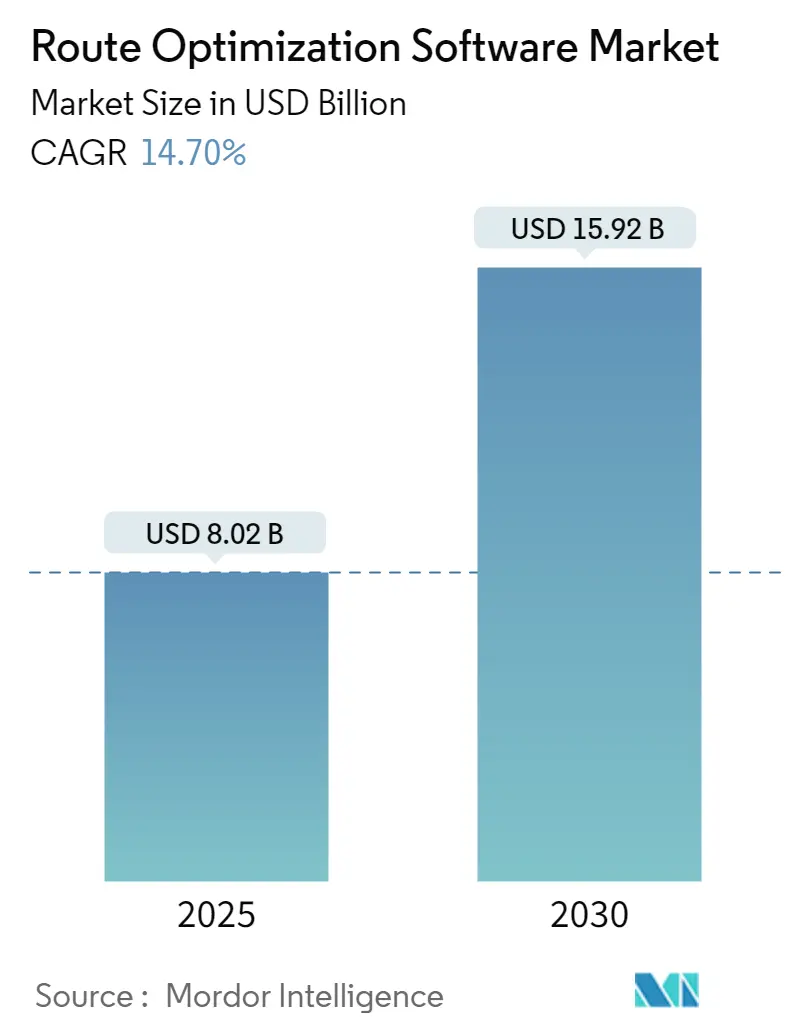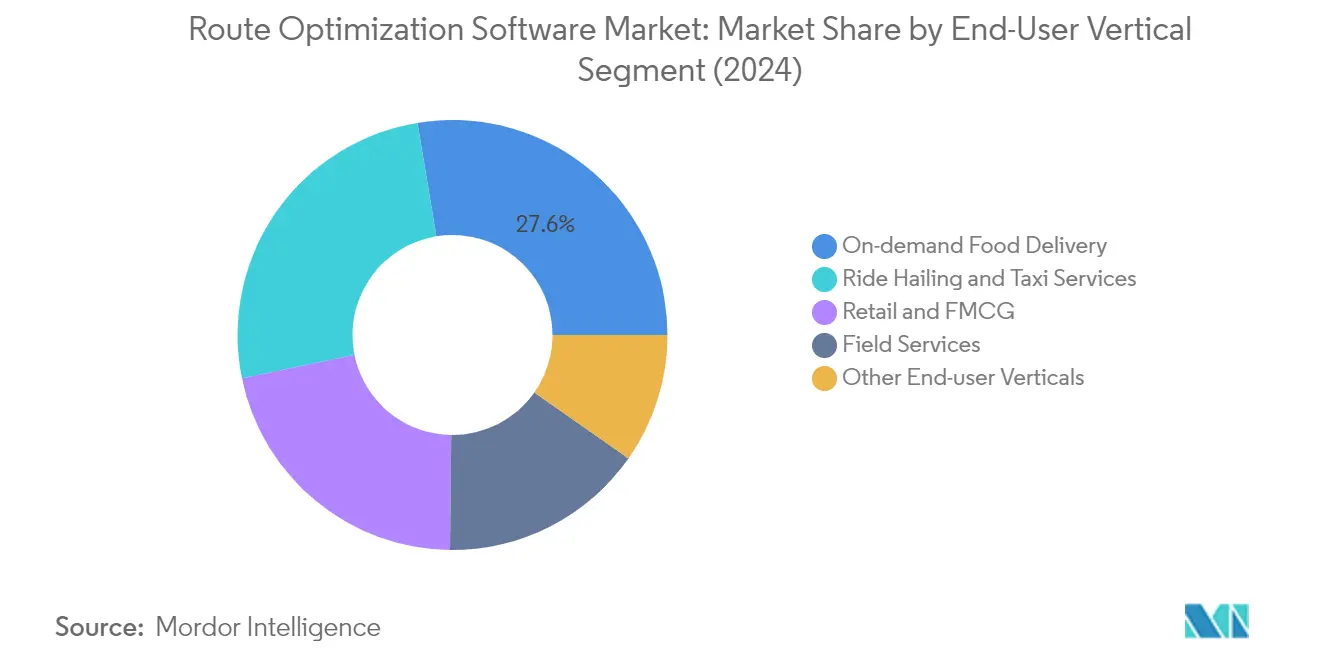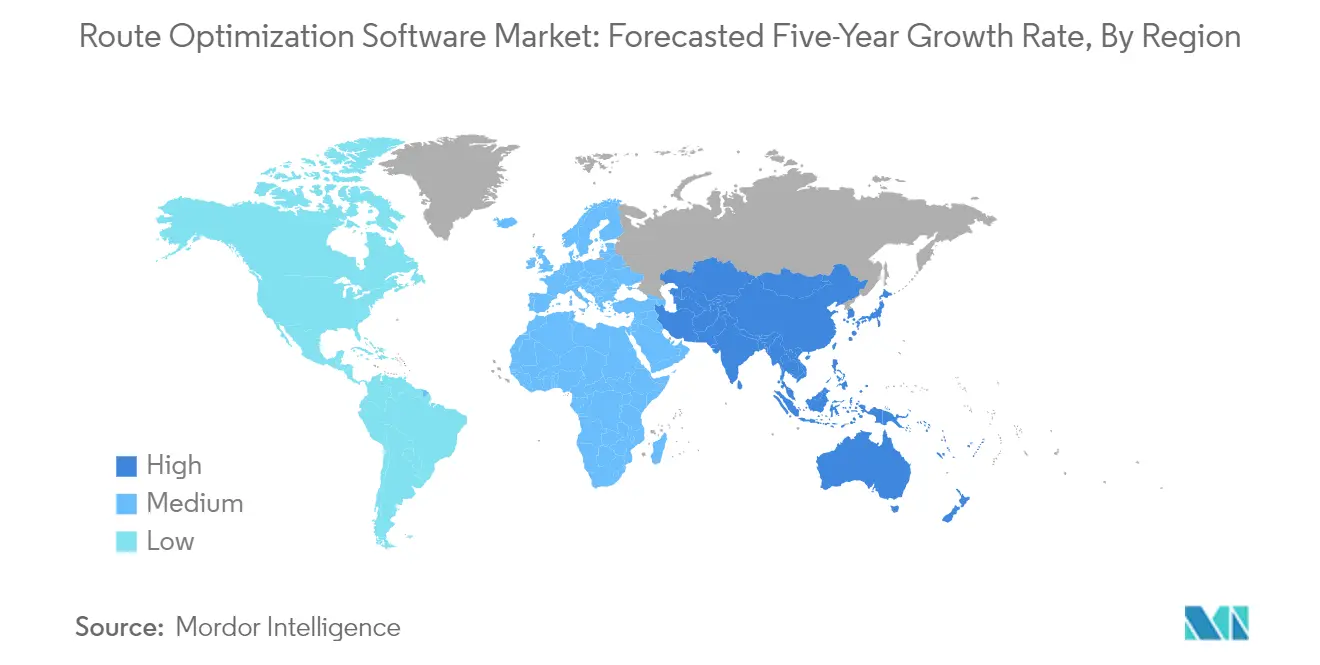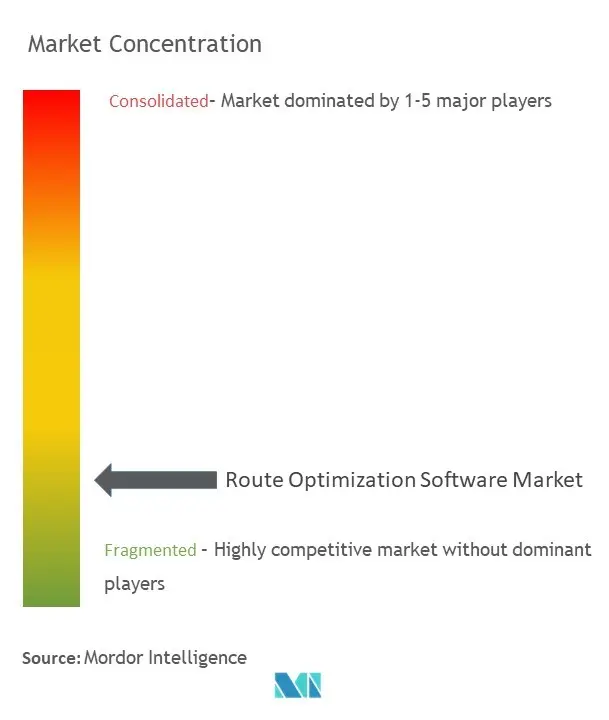
| Study Period | 2019 - 2030 |
| Market Size (2025) | USD 8.02 Billion |
| Market Size (2030) | USD 15.92 Billion |
| CAGR (2025 - 2030) | 14.70 % |
| Fastest Growing Market | Asia Pacific |
| Largest Market | North America |
| Market Concentration | Low |
Major Players
*Disclaimer: Major Players sorted in no particular order |
Route Optimization Software Market Analysis
The Route Optimization Software Market size is estimated at USD 8.02 billion in 2025, and is expected to reach USD 15.92 billion by 2030, at a CAGR of 14.7% during the forecast period (2025-2030).
The digital transformation of logistics and delivery services continues to accelerate, driven by increasing internet penetration and technological advancement. Global internet users reached 5.45 billion in 2023, facilitating the rapid growth of online ordering and delivery services. The surge in e-commerce activities has fundamentally altered consumer expectations around delivery speed and transparency, compelling businesses to adopt more sophisticated route optimization solutions. This digital shift has particularly impacted the food delivery and retail sectors, where real-time tracking and efficient route optimization have become essential competitive advantages.
The transportation industry is experiencing a significant shift toward sustainability and environmental consciousness, with the transport sector generating 8,104.75 million metric tons of carbon dioxide equivalent in 2022. This environmental concern has sparked innovation in route optimization software, with companies developing solutions that not only improve efficiency but also reduce carbon emissions. For instance, in September 2023, Routora launched an AI-powered app specifically designed to help eco-conscious travelers reduce their carbon footprint while optimizing routes, demonstrating the industry's commitment to sustainable logistics solutions.
The mobile technology landscape is rapidly evolving, with North America's smartphone adoption rate accounting for 84% of total mobile connections in 2023 and projected to reach 90% by 2030. This high smartphone penetration has catalyzed innovations in route optimization software, particularly in mobile-first solutions. In September 2023, Grubhub introduced its On-Demand Delivery feature, enabling self-delivery restaurants to request delivery drivers on a per-order basis, showcasing how route optimization is becoming more flexible and responsive to real-time demands.
The integration of artificial intelligence and machine learning technologies is revolutionizing route optimization capabilities. In August 2023, FarEye launched an AI-based dynamic routing solution for the trucking industry, while in July 2023, Singapore-based Kosmo introduced its fleet and route optimization solution promising up to 20% reduction in delivery costs. These technological advancements are enabling more sophisticated features such as real-time traffic integration, dynamic rerouting, and predictive analytics, fundamentally transforming how businesses approach route optimization and planning.
Route Optimization Software Market Trends
Increasing Use of Logistics-Specific Solutions
The surge in online shopping has created unprecedented pressure on logistics companies to deliver faster and cheaper, driving the adoption of specialized logistics solutions. Transportation route optimization software helps logistics companies plan time and fuel-efficient routes based on multiple factors including the number and location of stops, arrival/departure time gaps, and loading/unloading time. Unlike generic route planning solutions, logistics-specific route optimization software considers factors such as order urgency and multiple stops, ensuring the most efficient delivery operation while providing real-time data integration with traffic data to ensure efficient delivery time despite changing conditions.
The Biden-Harris Administration's commitment to achieving a carbon pollution-free electricity sector by 2035 and net-zero emissions economy-wide by 2050 has further accelerated the development of advanced route optimization software. Companies are responding with innovative solutions, as evidenced by Cargofive's recent EUR 1.8 million funding in June 2023 to modernize freight forwarding through a streamlined platform for route optimization and cost-efficient quotations. Additionally, in February 2023, Last Mile logistics software provider HyperTrack launched new features for its software platform, including comprehensive order fulfillment capabilities such as route optimization, fleet scheduling, and dynamic planning, demonstrating the industry's response to increasing demands for specialized logistics solutions.
Declining Hardware and Connectivity Costs
The reduction in hardware and connectivity costs has democratized access to route optimization software, enabling businesses of all sizes to implement these solutions. This affordability has particularly benefited small and medium-sized enterprises (SMEs) and businesses in emerging markets, where the availability of IT infrastructure was previously limited. The declining costs have made it possible for businesses to invest in route optimization software with reduced infrastructure costs and hardware upgrades, while cloud-based solutions offer scalability and flexibility, allowing businesses to adjust their computing resources based on changing needs with less capital investment.
The impact of reduced connectivity expenses extends beyond initial implementation costs. Supply-chain managers are negotiating with logistics partners to reduce fixed costs through automation to increase strategic flexibility. The optimal routes generated by the route optimization software minimize vehicle wear and tear, extending their lifespan and reducing additional maintenance costs. Companies are actively introducing new solutions to capitalize on these cost advantages, as demonstrated by FarEye's launch of an AI-based dynamic routing solution in August 2023, and Kosmo's introduction of a fleet and route optimization solution in July 2023 that helps businesses reduce delivery costs by up to 20% through its smart dispatching platform. These developments highlight how declining hardware and connectivity costs are enabling more sophisticated and accessible routing solutions across the industry.
Segment Analysis: By End-User Vertical
On-demand Food Delivery Segment in Route Optimization Software Market
The on-demand food delivery segment has emerged as the dominant force in the delivery route optimization software market, commanding approximately 28% market share in 2024. This significant market position is driven by dramatic shifts in consumer demand for food delivery services and evolving customer expectations for fast delivery times. The segment's prominence is further strengthened by high internet penetration and smartphone usage, which have prompted increased online food ordering, particularly among millennials who are shifting their preferences from conventional dining out to various on-demand food delivery services. Delivery optimization software has become critical for food delivery businesses to achieve maximum efficiency, ensure timely delivery while minimizing expenses, and provide accurate ETA calculations to improve the end-customer experience.

Retail and FMCG Segment in Route Optimization Software Market
The retail and FMCG segment is demonstrating remarkable growth potential, projected to expand at approximately 17% CAGR from 2024 to 2029. This accelerated growth is primarily driven by the sector's increasing focus on optimizing last-mile delivery operations and the rising need to streamline supply chain processes. The segment's growth is further fueled by the surge in e-commerce activities, leading to higher delivery volumes and complex logistics requirements. Route planning software helps retailers and FMCG companies manage the complexities of delivering goods to diverse locations, improving delivery speed and reducing costs while maintaining customer satisfaction. The adoption of these solutions enables complete tracking of warehouse performance, vehicle utilization, and store deliveries, making it an indispensable tool for modern retail operations.
Remaining Segments in End-User Vertical
The field services and ride-hailing and taxi services segments, along with other end-user verticals, play crucial roles in shaping the logistics software market. The field services segment is particularly notable for its application in utilities, telecommunications, and maintenance companies, where the software helps optimize technician routes and improve service response times. The ride-hailing and taxi services segment leverages fleet routing software to enhance driver efficiency and passenger experience. Other end-user verticals, including healthcare and construction sectors, are also adopting these solutions to streamline their operations and improve service delivery efficiency. These segments collectively contribute to the market's diversity and demonstrate the versatility of route optimization software across different industries.
Segment Analysis: By Size of the Organization
Large Enterprises Segment in Route Optimization Software Market
Large enterprises continue to dominate the fleet optimization software market, commanding approximately 52% market share in 2024. This significant market presence can be attributed to their substantial resources and ability to invest in comprehensive route optimization solutions. Large enterprises are increasingly leveraging machine learning and advanced analytics capabilities to build sophisticated functionalities, including intelligent geo-location, network design, route optimization, load aggregation, ETA prediction, and fraud detection. These organizations are particularly focused on implementing cloud-based route optimization solutions to improve productivity, transparency, and sustainability across their operations. The segment's dominance is further strengthened by multinational logistics providers utilizing these solutions to address critical challenges such as truck utilization, route consolidation, demand forecasting, facility placement, and inventory management.
Small and Medium Enterprise Segment in Route Optimization Software Market
The small and medium enterprise (SME) segment is experiencing remarkable growth, projected to expand at approximately 18% CAGR from 2024 to 2029. This accelerated growth is driven by the increasing accessibility of cloud-based solutions that offer more affordable and adaptable options for SMEs. The segment's growth is particularly notable in the on-demand food delivery sector, where SMEs are actively adopting delivery management software to enhance their logistics operations while maintaining strong customer relationships. The trend is further supported by the emergence of delivery partners and third-party logistics providers offering integrated solutions specifically designed for smaller businesses. This democratization of route optimization technology is enabling SMEs to build resilient and sustainable delivery systems without requiring large upfront investments, making it increasingly attractive for smaller organizations to implement these solutions.
Segment Analysis: By Deployment Mode
On-premise Segment in Route Optimization Software Market
The on-premise deployment segment continues to dominate the transportation routing software market, holding approximately 52% market share in 2024. This significant market position is primarily driven by organizations' preferences for greater control over their data and security infrastructure. On-premise solutions offer businesses the advantage of one-time licensing costs rather than recurring subscription fees, making them particularly attractive for enterprises with stable, long-term requirements. Organizations in sectors handling sensitive data, such as healthcare and financial services, particularly favor on-premise deployments due to enhanced data security and compliance capabilities. The segment's strength is further reinforced by the ability to customize solutions according to specific organizational needs, better integration with existing infrastructure, and reduced dependency on internet connectivity for critical operations. Additionally, large enterprises with established IT infrastructure continue to prefer on-premise solutions for their route optimization needs, particularly in regions with stringent data protection regulations.
Cloud Segment in Route Optimization Software Market
The cloud deployment segment is experiencing remarkable growth in the route optimization software market, projected to expand at approximately 18% CAGR from 2024 to 2029. This exceptional growth trajectory is driven by several key factors, including the increasing adoption of cloud-based solutions by small and medium-sized enterprises seeking cost-effective and scalable options. Cloud solutions are gaining traction due to their ability to provide real-time route optimization capabilities, seamless integration with other business systems, and reduced infrastructure maintenance requirements. The segment's growth is further accelerated by the rising demand for mobile accessibility, allowing businesses to manage their routing operations remotely. Advanced features such as automatic updates, enhanced scalability, and pay-as-you-go pricing models are making cloud-based solutions increasingly attractive to businesses of all sizes. The segment is also benefiting from continuous technological advancements in cloud computing, improved data security measures, and the growing trend toward digital transformation across industries.
Route Optimization Software Market Geography Segment Analysis
Route Optimization Software Market in North America
North America continues to maintain its dominant position in the global route optimization software market, commanding approximately 33% of the market share in 2024. The region's prominence can be attributed to its advanced technological infrastructure and high penetration of software vendors providing logistics route optimization solutions. Urban areas in North America face significant traffic congestion challenges, driving the adoption of route optimization software to navigate congested areas more efficiently. The region's e-commerce and online shopping growth has substantially increased last-mile delivery demands, necessitating sophisticated route management software. Cloud-based route optimization systems are gaining particular traction in North America, with businesses increasingly favoring scalable solutions that can adjust resources based on varying demands. The presence of major technology hubs and innovative startups has created a competitive environment that fosters continuous innovation in route optimization technologies. Additionally, the region's focus on reducing operational costs and improving delivery efficiency has led to increased investment in advanced routing solutions across various sectors, including food delivery, retail, and logistics.

Route Optimization Software Market in Europe
Europe has demonstrated robust growth in the route optimization software market, with an impressive growth rate of approximately 20% from 2019 to 2024. The region's market expansion is driven by increasing globalization, e-commerce expansion, and a growing need for sustainable logistics route optimization solutions. European countries are particularly focused on sustainability and environmental responsibility in their logistics operations, with stricter regulations and emissions targets pushing businesses to adopt sustainable transportation practices. The market has witnessed significant technological integration, with businesses leveraging advanced technologies like GPS, real-time traffic data, and cloud computing to enhance their logistics operations. The region's diverse economic landscape, comprising both established and emerging markets, has created varied opportunities for logistics routing software providers. European businesses are increasingly prioritizing customer experience through timely deliveries, driving the adoption of sophisticated routing solutions. The presence of strong automotive and logistics sectors further contributes to the market's growth, with companies seeking to optimize their transportation networks and reduce operational costs.
Route Optimization Software Market in Asia-Pacific
The Asia-Pacific region represents the most dynamic market for route optimization software, projected to grow at a remarkable CAGR of approximately 17% during 2024-2029. The region is experiencing significant urbanization and population growth, leading to increased congestion and city traffic challenges in major countries such as China, India, and Japan. The popularity of on-demand services, including food delivery, grocery delivery, and ride-hailing, has created a robust demand for efficient delivery route optimization solutions. The region's rapid digital transformation and increasing adoption of e-commerce platforms have necessitated advanced logistics solutions to manage complex delivery networks. Local businesses are increasingly recognizing the value of route optimization in logistics in reducing operational costs and improving service efficiency. The presence of a large manufacturing base and expanding retail sector further drives the need for sophisticated route planning solutions. Additionally, the region's diverse geographic landscape and varying infrastructure levels present unique challenges that route optimization software helps address. The growing focus on smart city initiatives and digital infrastructure development further supports market expansion.
Route Optimization Software Market in Latin America
Latin America represents an emerging market for route optimization software, driven by its rapidly growing middle class and burgeoning consumer market in countries like Brazil, Mexico, and Argentina. The region's logistics sector is undergoing significant digital transformation, with businesses increasingly adopting technological solutions to improve operational efficiency. The rapid growth of e-commerce in Latin America has transformed the retail landscape, creating increased demand for efficient last-mile delivery solutions. Local businesses are recognizing the importance of route optimization in maintaining competitiveness and meeting customer expectations for timely deliveries. The region's complex urban landscapes and varying infrastructure quality make route optimization particularly valuable for businesses operating across different territories. The presence of both international and local software providers has created a competitive environment that promotes innovation and accessibility of routing solutions. Additionally, the growing focus on cost reduction and operational efficiency among businesses has accelerated the adoption of route optimization technologies across various sectors.
Route Optimization Software Market in Middle East & Africa
The Middle East & Africa region presents unique opportunities for route optimization software, characterized by rapid economic growth and increasing urbanization in countries such as Saudi Arabia and the United Arab Emirates. The region's significant investments in infrastructure development projects are creating new opportunities for transportation optimization software implementation. The growing adoption of AI-driven technologies, particularly in the UAE, is driving innovation in routing solutions. The on-demand food delivery sector's expansion has created additional demand for efficient route planning tools. The region's diverse geographic landscape, from dense urban centers to remote areas, necessitates sophisticated routing solutions to manage delivery operations effectively. Local businesses are increasingly recognizing the value of route optimization in reducing operational costs and improving service efficiency. The presence of both international and regional software providers has created a competitive environment that promotes innovation and accessibility of routing solutions. Furthermore, the region's focus on smart city initiatives and digital transformation is expected to drive continued growth in the route optimization software market.
Route Optimization Software Market Overview
Top Companies in Route Optimization Software Market
The global route optimization software companies market features established players like Trimble Inc., Google LLC, Descartes Systems Group, and Verizon Connect Solutions alongside emerging specialists like Route4Me and Routific Solutions. Companies are heavily investing in artificial intelligence (AI) and machine learning capabilities to enhance their routing algorithms and provide more accurate, dynamic solutions. Strategic partnerships with logistics companies, e-commerce platforms, and technology providers have become crucial for expanding market reach and integrating complementary capabilities. Vendors are increasingly focusing on cloud-based deployments and mobile-first solutions to meet the growing demand for real-time route optimization services. The market is characterized by continuous product innovation, with companies introducing features like traffic-aware routing, driver familiarity optimization, and sustainability tracking to differentiate their offerings. Geographic expansion through both direct presence and channel partnerships remains a key growth strategy, particularly in emerging markets with growing e-commerce and logistics sectors.
Market Structure Shows Dynamic Competitive Environment
The route optimization software companies market exhibits a mix of global technology conglomerates and specialized software providers, creating a diverse competitive landscape. Large enterprises like Google and Verizon leverage their extensive technological infrastructure and research capabilities to offer comprehensive solutions integrated with their existing platforms, while specialized players like Ortec and PTV Group focus on developing deep domain expertise and tailored solutions for specific industries. The market shows moderate consolidation, with larger players actively pursuing acquisitions to expand their capabilities and market presence, particularly in acquiring companies with advanced AI and machine learning technologies.
Market competition is intensified by the presence of regional players who possess strong local market knowledge and established customer relationships in their respective territories. Strategic partnerships and collaborations have become increasingly common, particularly between software providers and logistics companies, as vendors seek to enhance their solution capabilities and expand their market reach. The market also witnesses continuous entry of new players, especially those focusing on specific niches like food delivery optimization or routing software for the service industry, contributing to the dynamic nature of competition.
Innovation and Integration Drive Future Success
Success in the route optimization value market increasingly depends on providers' ability to deliver comprehensive, integrated solutions that address the evolving needs of different industry verticals. Companies must focus on developing robust AI capabilities, ensuring seamless integration with existing enterprise systems, and providing flexible deployment options to maintain a competitive advantage. The ability to offer industry-specific solutions, particularly for high-growth sectors like e-commerce and food delivery, while maintaining scalability for enterprise-wide deployment, has become crucial for market success. Vendors must also address growing concerns around data security and privacy while ensuring their solutions can adapt to changing regulatory requirements across different regions.
For new entrants and smaller players, success lies in identifying and serving underserved market segments or developing specialized solutions for specific industries. The ability to provide superior customer support, ensure quick implementation, and demonstrate a clear return on investment has become critical for gaining market share. Companies must also focus on building strong partner ecosystems to enhance their market presence and service delivery capabilities. The increasing emphasis on sustainability and environmental concerns presents opportunities for providers to differentiate their offerings through features that optimize routes for reduced carbon emissions and improved fuel efficiency. Additionally, the ability to adapt to changing customer preferences and technological advancements while maintaining competitive pricing will be crucial for long-term success in this evolving market.
Route Optimization Software Market Leaders
-
Trimble, Inc.
-
Caliper Corporation
-
ESRI Global Inc,
-
Google LLC (Alphabet Inc.)
-
The Descartes Systems Group Inc.
- *Disclaimer: Major Players sorted in no particular order

Route Optimization Software Market News
- February 2024 - Verizon Connect announced new customizable term options, enabling business owners and fleet managers to tailor their contracts better to match their company’s specific needs. When new customers in the US, the UK, and IE sign up for Verizon Connect Reveal fleet management solutions, they can now choose how long a commitment they want to make. In addition to introducing more flexible contracts, Verizon Connect is making it easier for customers by investing in multiple areas, such as seamless installation, training and onboarding, user experience, and customer support.
- October 2023 - Google Maps launched various innovative AI-driven enhancements. These additions include an enhanced Street View experience, an augmented reality (AR) integrated lens in Maps, comprehensive search functionalities, and more. Immersive View for Places, powered by artificial intelligence, is a blend of thousands of street views and aerial images that enables users to see restaurants or landmarks ahead of their visit. In addition, with the recent introduction of photorealistic 3D tiles in Google Maps, developers can create innovative, immersive experiences. Such launches will help the company to optimize routes more efficiently.
Route Optimization Software Market Report - Table of Contents
1. INTRODUCTION
- 1.1 Study Assumptions and Market Definition
- 1.2 Scope of the Study
2. RESEARCH METHODOLOGY
3. EXECUTIVE SUMMARY
4. MARKET INSIGHTS
- 4.1 Market Overview
-
4.2 Industry Attractiveness - Porter's Five Forces Analysis
- 4.2.1 Bargaining Power of Suppliers
- 4.2.2 Bargaining Power of Buyers
- 4.2.3 Threat of New Entrants
- 4.2.4 Threat of Substitutes
- 4.2.5 Degree of Competition
- 4.3 Industry Value Chain Analysis
- 4.4 Impacts of Macro Trends on the Market
5. MARKET DYNAMICS
-
5.1 Market Drivers
- 5.1.1 Increasing Use of Logistics-Specific Solutions
- 5.1.2 Declining Hardware and Connectivity Costs
-
5.2 Market Restraints
- 5.2.1 Handling Structured and Unstructured Data
6. MARKET SEGMENTATION
-
6.1 By End-user Vertical
- 6.1.1 On-Demand Food Delivery
- 6.1.2 Retail and FMCG
- 6.1.3 Field Services
- 6.1.4 Ride Hailing and Taxi Services
- 6.1.5 Other End-user Verticals
-
6.2 By Size of the Organization
- 6.2.1 Small and Medium Enterprise
- 6.2.2 Large Enterprises
-
6.3 By Deployment Mode
- 6.3.1 Cloud
- 6.3.2 On-Premise
-
6.4 By Geography
- 6.4.1 North America
- 6.4.2 Europe
- 6.4.3 Asia-Pacific
- 6.4.4 Latin America
- 6.4.5 Middle East and Africa
7. COMPETITIVE LANDSCAPE
-
7.1 Company Profiles*
- 7.1.1 Trimble Inc.
- 7.1.2 Caliper Corporation
- 7.1.3 The Descartes Systems Group Inc.
- 7.1.4 ESRI Global Inc.
- 7.1.5 Google LLC (Alphabet Inc.)
- 7.1.6 TrackoBit (InsightGeeks Solutions Pvt. Ltd)
- 7.1.7 Microlise Group PLC
- 7.1.8 Omnitracs LLC
- 7.1.9 Ortec BV
- 7.1.10 Paragon Software Systems PLC
- 7.1.11 PTV Planung Transport Verkehr GMBH
- 7.1.12 Route4me LLC
- 7.1.13 Routific Solutions Inc.
- 7.1.14 Verizon Connect Solutions Inc.
- 7.1.15 WorkWave LLC
8. INVESTMENT ANALYSIS
9. FUTURE OF THE MARKET
Route Optimization Software Market Industry Segmentation
The route optimization software market is defined based on the revenues generated from the software used in various end-user verticals across the world. The analysis is based on the market insights captured through secondary research and the primaries. The market also covers the major factors impacting its growth in terms of drivers and restraints.
The route optimization software market is segmented by end-user vertical (on-demand food delivery, retail, and FMCG, ride-hailing and taxi services, and other end-user verticals), size of the organization (small and medium enterprises, large enterprises), deployment mode (cloud, on-premises), and geography (North America, Europe, Asia-Pacific, Latin America, and Middle East and Africa). The market sizes and forecasts are provided in terms of value in USD for all the above segments.
| By End-user Vertical | On-Demand Food Delivery |
| Retail and FMCG | |
| Field Services | |
| Ride Hailing and Taxi Services | |
| Other End-user Verticals | |
| By Size of the Organization | Small and Medium Enterprise |
| Large Enterprises | |
| By Deployment Mode | Cloud |
| On-Premise | |
| By Geography | North America |
| Europe | |
| Asia-Pacific | |
| Latin America | |
| Middle East and Africa |
Route Optimization Software Market Research FAQs
How big is the Route Optimization Software Market?
The Route Optimization Software Market size is expected to reach USD 8.02 billion in 2025 and grow at a CAGR of 14.70% to reach USD 15.92 billion by 2030.
What is the current Route Optimization Software Market size?
In 2025, the Route Optimization Software Market size is expected to reach USD 8.02 billion.
Who are the key players in Route Optimization Software Market?
Trimble, Inc., Caliper Corporation, ESRI Global Inc,, Google LLC (Alphabet Inc.) and The Descartes Systems Group Inc. are the major companies operating in the Route Optimization Software Market.
Which is the fastest growing region in Route Optimization Software Market?
Asia Pacific is estimated to grow at the highest CAGR over the forecast period (2025-2030).
Which region has the biggest share in Route Optimization Software Market?
In 2025, the North America accounts for the largest market share in Route Optimization Software Market.
What years does this Route Optimization Software Market cover, and what was the market size in 2024?
In 2024, the Route Optimization Software Market size was estimated at USD 6.84 billion. The report covers the Route Optimization Software Market historical market size for years: 2019, 2020, 2021, 2022, 2023 and 2024. The report also forecasts the Route Optimization Software Market size for years: 2025, 2026, 2027, 2028, 2029 and 2030.
Our Best Selling Reports
Route Optimization Software Market Research
Mordor Intelligence provides comprehensive industry analysis and market insights for the route optimization software market, covering crucial aspects like market size, growth trends, and competitive landscape. Our detailed research encompasses various segments including fleet management software, transportation management software, and logistics optimization software, delivering actionable intelligence through easy-to-navigate report PDF formats. The report examines market dynamics across route optimization solutions, delivery management software, and route planning software, offering stakeholders a thorough understanding of industry trends, technological innovations, and growth opportunities in the route optimization industry.
Our consulting expertise extends beyond traditional market research to provide strategic insights for businesses operating in the route optimization software space. We assist clients with technology scouting to identify cutting-edge routing algorithms, conduct competition assessment of leading route optimization companies, and perform customer need analysis to optimize solution offerings. Our capabilities include B2B surveys with fleet management software users, assessment of transportation routing software implementations, and analysis of logistics route optimization strategies. Through data aggregation and advanced visualization techniques, we help stakeholders make informed decisions about market entry, product development, and strategic partnerships in the route optimization solutions ecosystem.




